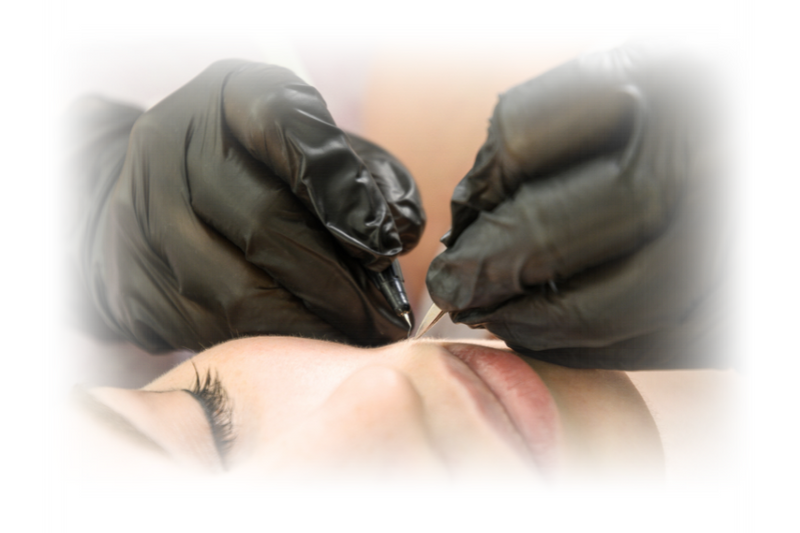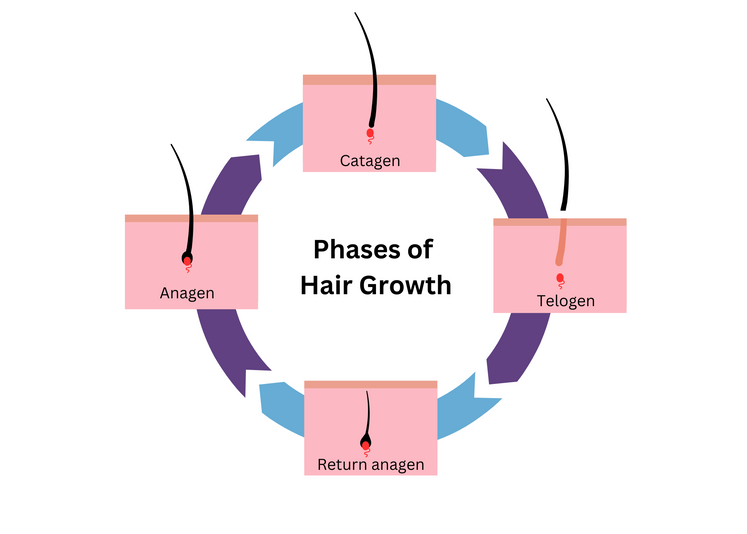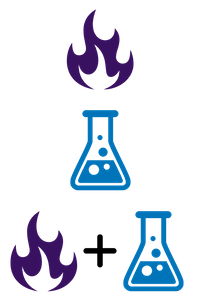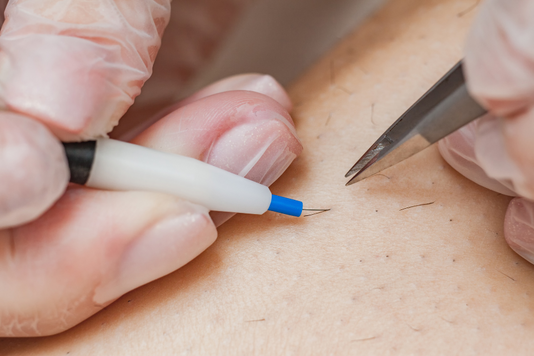
Electrolysis Hair removal
- What Laser Cannot Treat, Your Electrologist Can!
Achieve permanent hair removal with our expert electrolysis services. Safe, precise, and effective for all hair colors and skin types, electrolysis targets each follicle for lasting results. Experience the confidence of smooth, flawless skin with Permanent Choice.
How Electrolysis Works
Electrolysis works by inserting a fine probe into each hair follicle, delivering a small electrical current that disrupts the follicle’s ability to produce hair. With repeated treatments, this process leads to permanent hair removal. Unlike other methods, electrolysis is effective on all hair colors and skin types, making it a versatile solution for achieving smooth, hair-free skin.
Electrolysis is the only FDA-approved method for permanent hair removal, but it requires time and patience since it treats each hair individually. Follicles need to be broken down ⅔ of the way before it cannot produce another hair, this can happen on the 1ˢᵗ treatment or over time. The number of electrolysis treatments needed varies per client, as factors like hormones, medications, medical conditions, and genetics influence results. Session length depends on the number of hairs, hair resistance, and your comfort level. Best results are achieved when treatments are performed every 1 - 3 weeks
*Please note, we are currently only accepting electrolysis clients for the area of the face.

Electrolysis is most effective on hair in the Anagen phase because the hair follicle is fully connected to the root, allowing the treatment to target and disable the follicle more effectively.
Hair growth occurs in a cycle that includes three main phases: Anagen, Catagen, and Telogen.
Anagen (Active Growth Stage): The Anagen phase can last anywhere from 4-8 weeks. It is during this phase that the hair contains the most pigment, and is attached to the blood supply, making it the most effective stage for electrolysis hair removal treatment.
Catagen (Dormant Stage): The hair stops growing, the follicle shrinks and is preparing to shed. The Catagen phase typically lasts for about 10-20 days.
Telogen (Shedding Stage): During this phase, the hair is fully detached from the follicle and falls out. The Telogen phase lasts around 3-4 months. After this phase, the follicle returns to the Anagen phase, and the cycle begins again.

Modalities
There are 3 modalities of electrolysis treatment: Thermolysis, Galvanic, and Blend. Our electrolysis machines, the Apilus XCell Plus, utilize all 3.
Thermolysis (Flash) uses a small alternating current to cauterize hair follicles, making it ideal for treating thin, fine hairs. It's often what people imagine when they think of electrolysis.
Galvanic works by utilizing a current that converts the salts and water in the follicle into lye which breaks the hair bulb down.
Blend combines Galvanic and Thermolysis techniques, utilizing both heat and chemical reactions to effectively remove thick, coarse hairs. It's one of the most effective methods for permanent hair removal.
Who is a Candidate?
Ideal Candidates:
Electrolysis is ideal for treating black, brown, blonde, gray, and red hair, or for clients that are not candidates for laser such as clients with darker skin tones, are pregnant, on sun/photosensitizing medications, or are unable to avoid prolonged sun exposure.
Candidates should be in good health, free from skin irritations or infections in the treatment area.
Unideal Candidates:
While electrolysis is safe for most people, it may not be suitable for individuals with certain skin conditions or prone to keloids. Clients with medical conditions that affect healing should consult with a doctor prior to treatment. People who've had recent cosmetic injections, or are taking blood thinners may need to delay treatment.
It's important to discuss health concerns or skin sensitivities with your technician before starting electrolysis to ensure it’s the right choice for you.
What to expect
* Adverse reactions are rare and can be unpredictable. Due to this, we will not perform a procedure two weeks prior to a special event (e.g. wedding, reunion, interview, etc.)
* Due to the nature of our services, children are not allowed in the treatment room and must be accompanied by an adult in the lobby.
Pre-Treatment:
Preparation:
Hair length: For electrolysis, we need 3 - 4 days of hair growth present when you arrive at each session.
- Avoid Tweezing or Waxing: You cannot tweeze, wax, epilate or thread 2 weeks before your 1ˢᵗ session or between electrolysis sessions.
Hydrate: Staying well-hydrated enhances the effectiveness of electrolysis by improving the conductivity of the skin, allowing the treatment to work more efficiently.
Skin Care: Chemical peels, facials, dermaplaning, and cosmetic injections should be avoided 1 week before and after treatment of the same area.
Medical Considerations:
Before beginning treatment, discuss any of the following conditions with your technician:
- Cold sores
- Herpes
- Lupus
- Melanoma
- Tendency to keloid
- Psoriasis
- Pigmentary issues
Electrolysis may not be suitable for those with certain skin conditions, keloid scarring, or medical conditions that affect healing. Clients on blood thinners may need to delay treatment.
*Discuss any health concerns or skin sensitivities with your technician before starting.

Day of Treatment:
Clients should arrive at appointments with clean skin, free of lotions, make-up, sprays, or creams in the treatment area.
*If you have not filled out the online intake form, please arrive 10 minutes early to fill out this form.
- Consultation: During your consultation, you'll meet with an experienced technician who'll discuss your hair removal goals, assess your skin and hair type, and recommend a personalized treatment plan.
- Sensation: Most clients describe the feeling as a sharp sting, a rubber band snap or a mild tingling. You will also feel pressure from your technician stretching your skin to allow a clean probe insertion.
Atmosphere: For most clients talking during sessions is difficult, so clients are welcome to bring headphones to help calm their minds.
Your first visit will typically involve 10-15 minutes of treatment to help determine your treatment plan.

Post-Treatment:
Immediate Effects: Expect redness, bumps and some swelling in the treated area, which may last up to 2 hours or longer for some individuals. A sunburn-like sensation is normal and may continue into the next day. Use a cold compress, aloe vera gel, or witch hazel if needed to aid in soothing. Small pinpoint scabbing is normal and should be treated with care. Do not touch or pick at any scabbing. Be sure to inform your Electrologist if you do experience scabbing.
Long Term Effects: After each treatment, the hair will either not grow back or if it does, it grows back finer and lighter until the follicle is no longer able to reproduce a hair.
Aftercare:
Hygiene: Use tepid water and mild soap. Pat the skin dry—do not rub. Keep treatment areas clean by utilizing products like antiseptic skin washes, witch hazel, hydrogen peroxide, or 70% isopropyl alcohol.
Avoid: Hot tubs, pools, and public gyms for 24 hours to prevent bacterial exposure. Avoid topical medications 5 days before or after treatment. Do not pick, scratch, tweeze, or wax the treated area. Hyperpigmentation (darkening) or hypopigmentation (lightening) is a risk if you pick or scratch when the skin is healing.
Protection: Apply an antiseptic ointment like bacitracin. (Neosporin is not recommended)
Makeup: Use only fresh makeup purchased within 90 days, and new/cleaned applicators and brushes.
If you have any questions or concerns regarding electrolysis instructions or treatments, please contact us at (952) 898-1111
